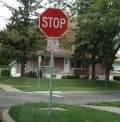Roundabouts of Britain
British and Overseas Roundabouts
Click thumbnail to view full-size





Help! It's Another Roundabout!
Roundabouts of Britain
Roundabouts hold no little fascination for many people who have to use one or many of them on a daily basis. Some resemble islands in the stream of traffic, whereas others, the “mini” variety, are often no more than a painted circle, which drivers ignore and bisect with aplomb…or an apple if plombs are out of season.
Although their proliferation has been slow and steady in the main, roundabouts have been with us nearly as long as the motor car; in fact, a few may have even been constructed to ease the passage of the horse and trap; I’m unsure of this though. The first proper traffic roundabout was the one at Sollershott Circus, Letchworth. opened in 1909 and had to wait a few years until it became truly part of the “gyratory flow” system in 1920. (The first mini-roundabout is said to be that at Headless Cross in Worcestershire).
It wasn’t until well into the late 1960’s that nations such as Australia, New Zealand and the rest of Europe caught the roundabout bug and they began to replace traffic lights as being faster and safer in merging traffic flows. (see conflicting opinions following).
I believe the term roundabouts may have been invented in the United States, but they were certainly used more here for the first half of the last century until they began to catch-on everywhere.
I spent some years living in the most populous city on earth at the time, Mexico City of 25 million souls, give or take a million or so. Some of the roundabouts there are huge affairs with permanent gardening staff, some of whom live happily on the traffic island itself! Others have underground chambers and passages and mature, 100-foot trees on them and are often a riot of foliage and bright flowers. Still more have footpaths, taco shops and parking aboard them! Not at all like ours in sanitized and boring Britain. Needless to say that the jobs are prized and handed down in families or bought with a “mordida” (“bite,” a bribe) changing hands.
If you wonder why it is so many learner drivers are seen going round roundabouts in the UK it is because they are not for the faint-hearted driver and need plenty of practice. When I returned to the UK in 2003, I had to learn to navigate them safely all over again, as they are nowhere near as common in other countries and mostly of the simple variety. In Britain, the new driver has to learn all about the new forms and configurations seemingly heartless traffic architects have had built. The worst for me by far (still are) were the double roundabout, where one circle spills you out on to another and then perhaps even a third. These often find me - and many learners - chugging round and around until their scrambled brains can work out where they have to go - and other road users are merciless! Another situation often having me - and many others for sure - in trouble is when I want to go straight ahead but get boxed in by the driver to my right and I have to vigorously brake and get in behind him…usually a white van, the sadists of UK highways.
Conflicting Opinions. They are part of the ethos of travel here and are increasing all the time, but they have their detractors who point out that they dramatically slow approaching traffic; they can be hazardous to large vehicles and the palpitating minnows around them; there is no traffic control on most of them; they are expensive to build and maintain (in the case of full sized examples); they definitely confuse new, nervous and foreign drivers and we have to suffer too many of them, especially the minis and there ilk which are appearing like a rash on our roads.
However, there can be no doubt that many of them add beauty as well as convenience to our journeys and much imagination has been used by designers to make them memorable. The trend has been away from the forested look lately and the “modern roundabouts” often use dramatic and stark adornments.
I especially like the huge Brunel Roundabout in Slough, the one near De Monfort Uni in Milton Keys with the statues on top (who are they?), the stunning roundabout in Telford with what looks like a space station on it, (Telford has a plethora of quality, imaginative roundabouts), The island-like Mermaid Quay roundabout in Cardiff, the Midpoint Roundabout in the Midlands with its upside-down pyramid, the “tropical island” in Tamworth - quite an oasis, the little traffic island in Ilfracombe, on the seafront, with the ornate Victorian ironwork. and, best of all, the compelling roundabout in South Devon with the high stump of a once majestic tree on it, many yards in circumference, with seats and carving in it. But I can’t help seeing a huge old tree or its remains in Britain without thinking how it must have been once with endless forests everywhere and the giant oaks and all the rest. No wonder the Romans wanted to come and live here - back then.
There are many, many more roundabouts in the UK and other countries, so many, in fact, that they have attracted spotters as have trains, who have formed a couple of organizations…that’s the bloke that caused the accident you were involved with last week while he was making notes going round one of the myriad roundabouts in Horrible Harlow, Essex…!














